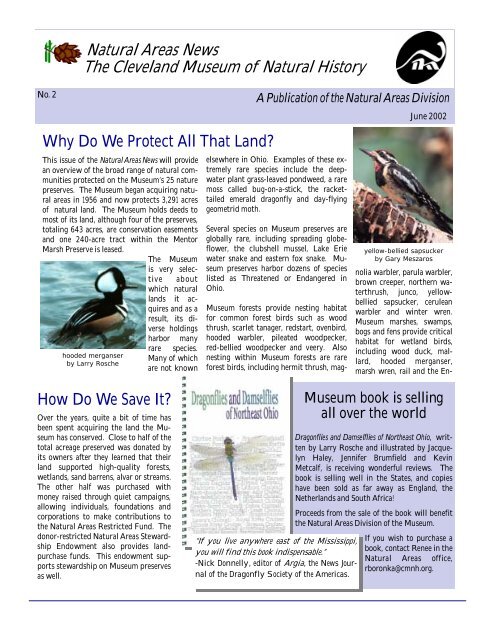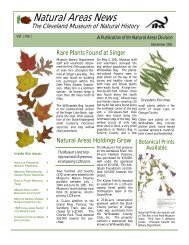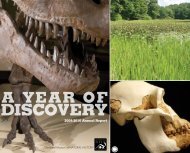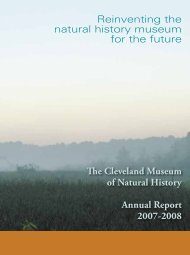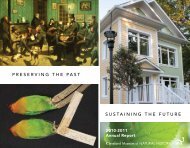Natural Areas News The Cleveland Museum of Natural History
Natural Areas News The Cleveland Museum of Natural History
Natural Areas News The Cleveland Museum of Natural History
Create successful ePaper yourself
Turn your PDF publications into a flip-book with our unique Google optimized e-Paper software.
No. 2<br />
<strong>Natural</strong> <strong>Areas</strong> <strong>News</strong><br />
<strong>The</strong> <strong>Cleveland</strong> <strong>Museum</strong> <strong>of</strong> <strong>Natural</strong> <strong>History</strong><br />
Why Do We Protect All That Land?<br />
This issue <strong>of</strong> the <strong>Natural</strong> <strong>Areas</strong> <strong>News</strong> will provide<br />
an overview <strong>of</strong> the broad range <strong>of</strong> natural communities<br />
protected on the <strong>Museum</strong>’s 25 nature<br />
preserves. <strong>The</strong> <strong>Museum</strong> began acquiring natural<br />
areas in 1956 and now protects 3,291 acres<br />
<strong>of</strong> natural land. <strong>The</strong> <strong>Museum</strong> holds deeds to<br />
most <strong>of</strong> its land, although four <strong>of</strong> the preserves,<br />
totaling 643 acres, are conservation easements<br />
and one 240-acre tract within the Mentor<br />
Marsh Preserve is leased.<br />
<strong>The</strong> <strong>Museum</strong><br />
is very selective<br />
about<br />
which natural<br />
lands it acquires<br />
and as a<br />
result, its diverse<br />
holdings<br />
harbor many<br />
hooded merganser<br />
by Larry Rosche<br />
How Do We Save It?<br />
Over the years, quite a bit <strong>of</strong> time has<br />
been spent acquiring the land the <strong>Museum</strong><br />
has conserved. Close to half <strong>of</strong> the<br />
total acreage preserved was donated by<br />
its owners after they learned that their<br />
land supported high-quality forests,<br />
wetlands, sand barrens, alvar or streams.<br />
<strong>The</strong> other half was purchased with<br />
money raised through quiet campaigns,<br />
allowing individuals, foundations and<br />
corporations to make contributions to<br />
the <strong>Natural</strong> <strong>Areas</strong> Restricted Fund. <strong>The</strong><br />
donor-restricted <strong>Natural</strong> <strong>Areas</strong> Stewardship<br />
Endowment also provides landpurchase<br />
funds. This endowment supports<br />
stewardship on <strong>Museum</strong> preserves<br />
as well.<br />
rare species.<br />
Many <strong>of</strong> which<br />
are not known<br />
A Publication <strong>of</strong> the <strong>Natural</strong> <strong>Areas</strong> Division<br />
elsewhere in Ohio. Examples <strong>of</strong> these extremely<br />
rare species include the deepwater<br />
plant grass-leaved pondweed, a rare<br />
moss called bug-on-a-stick, the rackettailed<br />
emerald dragonfly and day-flying<br />
geometrid moth.<br />
Several species on <strong>Museum</strong> preserves are<br />
globally rare, including spreading globeflower,<br />
the clubshell mussel, Lake Erie<br />
water snake and eastern fox snake. <strong>Museum</strong><br />
preserves harbor dozens <strong>of</strong> species<br />
listed as Threatened or Endangered in<br />
Ohio.<br />
<strong>Museum</strong> forests provide nesting habitat<br />
for common forest birds such as wood<br />
thrush, scarlet tanager, redstart, ovenbird,<br />
hooded warbler, pileated woodpecker,<br />
red-bellied woodpecker and veery. Also<br />
nesting within <strong>Museum</strong> forests are rare<br />
forest birds, including hermit thrush, mag-<br />
“If you live anywhere east <strong>of</strong> the Mississippi,<br />
you will find this book indispensable.”<br />
-Nick Donnelly, editor <strong>of</strong> Argia, the <strong>News</strong> Journal<br />
<strong>of</strong> the Dragonfly Society <strong>of</strong> the Americas.<br />
June 2002<br />
yellow-bellied sapsucker<br />
by Gary Meszaros<br />
nolia warbler, parula warbler,<br />
brown creeper, northern waterthrush,<br />
junco, yellowbellied<br />
sapsucker, cerulean<br />
warbler and winter wren.<br />
<strong>Museum</strong> marshes, swamps,<br />
bogs and fens provide critical<br />
habitat for wetland birds,<br />
including wood duck, mallard,<br />
hooded merganser,<br />
marsh wren, rail and the En-<br />
<strong>Museum</strong> book is selling<br />
all over the world<br />
Dragonflies and Damselflies <strong>of</strong> Northeast Ohio, written<br />
by Larry Rosche and illustrated by Jacquelyn<br />
Haley, Jennifer Brumfield and Kevin<br />
Metcalf, is receiving wonderful reviews. <strong>The</strong><br />
book is selling well in the States, and copies<br />
have been sold as far away as England, the<br />
Netherlands and South Africa!<br />
Proceeds from the sale <strong>of</strong> the book will benefit<br />
the <strong>Natural</strong> <strong>Areas</strong> Division <strong>of</strong> the <strong>Museum</strong>.<br />
If you wish to purchase a<br />
book, contact Renee in the<br />
<strong>Natural</strong> <strong>Areas</strong> <strong>of</strong>fice,<br />
rboronka@cmnh.org.
No. 2<br />
Stewardship on <strong>Museum</strong> Preserves<br />
Summer is upon us. It’s time to meet a<br />
new group <strong>of</strong> conservation interns and<br />
begin summer stewardship projects.<br />
Preserve stewardship is a major responsibility<br />
<strong>of</strong> the <strong>Natural</strong> <strong>Areas</strong> Division.<br />
It includes restoring rare natural<br />
communities, removing alien plants,<br />
monitoring and mapping rare species<br />
or natural communities and restoring<br />
important habitat for local or declining<br />
species. Much <strong>of</strong> this work is accomplished<br />
by conservation interns, who<br />
are hired each summer. During<br />
previous summers, the interns<br />
cleared large sections <strong>of</strong> the<br />
North Kingsville Sand Barrens<br />
and worked on removing plants<br />
such as myrtle from the forest<br />
floor <strong>of</strong> several <strong>of</strong> our preserves.<br />
<strong>The</strong> invasion <strong>of</strong> garlic mustard<br />
has required the division to hire<br />
outside contractors to control<br />
its spread. This spring, large<br />
stands <strong>of</strong> garlic mustard were<br />
treated with herbicide at the<br />
Managing for West Virginia Whites!<br />
Preserving <strong>Museum</strong> populations <strong>of</strong> the<br />
woodland butterfly West Virginia<br />
white is a major reason garlic mustard<br />
was removed from the Grand River<br />
Terraces and Cottonwood Hollow this<br />
spring. Garlic mustard is currently<br />
invading northeastern Ohio woodlands<br />
and choking out native wildflowers,<br />
such as toothwort, the host<br />
plant for West Virginia whites. <strong>The</strong><br />
West Virginia white<br />
By Jay Cossey<br />
Garlic mustard not only chokes out<br />
native toothworts, but also kills the<br />
caterpillars <strong>of</strong> West Virginia whites.<br />
increasing deer herd in northeastern Ohio is<br />
also partly responsible for the rapid, recent<br />
invasion <strong>of</strong> garlic mustard. Deer avoid eating<br />
garlic mustard and graze the native woodland<br />
wildflowers instead.<br />
Caterpillars <strong>of</strong> the butterfly feed on native<br />
toothworts, especially two-leaved toothwort.<br />
Garlic mustard not only chokes out<br />
native toothworts, but also kills the caterpillars<br />
<strong>of</strong> West Virginia whites. West Virginia<br />
whites mistake the garlic mustard<br />
for toothwort and lay their<br />
eggs on it. <strong>The</strong> strong mustard<br />
oils kill the caterpillars.<br />
Protect Hemlock Forests, Protect Birds<br />
Hemlock forests provide nesting habitat for several rare birds. Hermit<br />
thrush, dark-eyed junco, winter wren, magnolia warbler and parula warbler<br />
have been observed on <strong>Museum</strong> preserves during the breeding season.<br />
<strong>The</strong> <strong>Museum</strong> Preserves support two different types <strong>of</strong> hemlock forest.<br />
<strong>The</strong> hemlock swamp forest that is present at the Grand River Terraces,<br />
North Kingsville Sand Barrens and Cathedral Woods is an Endangered<br />
plant community in Ohio. Most hemlock swamps in Ohio are confined<br />
to Ashtabula County. Hemlock mixed hardwood forests are found<br />
on seven <strong>Museum</strong> Preserves. This type <strong>of</strong> forest can harbor hermit<br />
thrush, winter wren and magnolia warbler.<br />
garlic mustard<br />
by Greg Petusky<br />
Page 2<br />
Grand River Terraces, Cottonwood<br />
Hollow and<br />
Singer Lake Bog Preserves.<br />
To impede the spread <strong>of</strong><br />
garlic mustard yourself,<br />
hand pull or spray the plant<br />
with herbicide, such as<br />
Round-Up®, before it flowers<br />
in early spring. If flowering<br />
has begun, the flower<br />
head must be cut <strong>of</strong>f and<br />
burned to stop seeds from<br />
forming.<br />
Garlic mustard is threatening West<br />
Virginia whites within their entire<br />
range, from northeastern Ohio east to<br />
the central and southern Appalachians.<br />
Even before the garlic mustard<br />
threat, West Virginia whites were<br />
local throughout their range and absent<br />
from many woodlands.<br />
<strong>The</strong> <strong>Museum</strong>’s Grand River Terraces,<br />
Hadlock Preserve and North Kingsville<br />
Sand Barrens support large populations<br />
<strong>of</strong> this beautiful butterfly.<br />
Botanical Notecards are<br />
now on sale in <strong>The</strong> Ark in<br />
t h e P a r k Mu se u m<br />
Store. Each pack <strong>of</strong> notecards<br />
contains eight different designs based on specimens<br />
from the <strong>Museum</strong> Herbarium. A special thank you to<br />
<strong>Museum</strong> Graphic Designer Kelli Payto for creating such<br />
elegant designs. Proceeds benefit the Botany Department.
No. 2<br />
Carex garberi<br />
Spotlight on Three Significant <strong>Natural</strong> Communities<br />
Bogs & Fens<br />
Kelleys Island Alvars blanda), Philadelphia panic grass (Panicum<br />
Most <strong>of</strong> the 114 acres owned by the <strong>Museum</strong> on<br />
Kelleys Island are home to an important Great<br />
Lakes community called an alvar. Alvar communities<br />
are forests, shrub communities, barrens<br />
or wetlands that grow on thin soils over<br />
limestone or dolomite.<br />
<strong>Museum</strong> alvar communities support several<br />
rare plants and reptiles. State-Threatened<br />
Rock elm (Ulmus thomasii), smooth rose (Rosa<br />
Sand Barrens/Oak Savannahs<br />
Oak savannah communities, dominated by black<br />
oak with sand barren openings, were once common<br />
along the inland beach ridges south <strong>of</strong> Lake<br />
Erie and on the glacial sand and gravel deposits in<br />
Portage, Summit, Stark and Wayne counties. Oak<br />
savannah was especially common in Ravenna,<br />
Kent, Akron and Canton. Today, few good examples<br />
<strong>of</strong> this community remain in northeastern<br />
Ohio, and it is considered one <strong>of</strong> the most threatened<br />
natural communities in the Great Lakes region.<br />
<strong>The</strong> <strong>Museum</strong> owns two outstanding sand barren/<br />
oak savannah tracts. <strong>The</strong> numerous bogs within the 150-acre<br />
Singer Lake Basin in Summit County are surrounded by glacial<br />
sand and gravel deposits and the North Kingsville Sand Barren<br />
in Ashtabula County sits on the Lake Warren beach ridge.<br />
Bogs and fens are rare<br />
glacial wetlands that<br />
harbor relic plant<br />
communities that moved into northern<br />
Ohio during the Ice Age. <strong>The</strong>se wetlands<br />
are also known as peatlands because the<br />
soils underlying them, called histosols, are<br />
composed <strong>of</strong> partially decomposed plant<br />
material called peat. <strong>The</strong> bulk <strong>of</strong> the peat<br />
in bogs is dead sphagnum moss. <strong>The</strong> peat<br />
in <strong>Museum</strong> peatlands was deposited in the<br />
bog lakes and fen springs over thousands<br />
<strong>of</strong> years as the glaciers retreated.<br />
<strong>The</strong> resulting peatlands<br />
range from a few feet to 40 feet<br />
deep. Fens are alkaline peatlands with a high<br />
pH, <strong>of</strong>ten 7.7. Bogs are acidic peatlands with<br />
a pH generally around 4.<br />
racket-tailed emerald<br />
by Jennifer Brumfield<br />
<strong>The</strong> <strong>Museum</strong> has purchased<br />
two <strong>of</strong> the region’s best fens,<br />
Pymatuning Creek Fen in<br />
Ashtabula County and Koelliker<br />
Fen in Geauga County.<br />
<strong>The</strong> <strong>Museum</strong> bought its first<br />
bog, Fern Lake Bog in Geauga<br />
County, in 1956. In 1998, the<br />
<strong>Museum</strong> began acquiring<br />
Singer Lake, the largest and<br />
finest bog system remaining in<br />
Ohio.<br />
<strong>The</strong> <strong>Museum</strong>’s bogs and<br />
fens support dozens <strong>of</strong> rare plants and<br />
animals. Rare dragonflies inhabit all <strong>of</strong><br />
them, and several plant species on Mu-<br />
Page 3<br />
Rosa blanda<br />
philadelphicum) and blue-eyed grass<br />
(Sisyrinchum montanum) are found here,<br />
as well as the State-Endangered garber<br />
sedge (Carex garberi), eastern fox snake,<br />
which has special interest status in Ohio,<br />
and the Federally-Threatened Lake Erie<br />
water snake (Nerodia sipedon insularum). Several<br />
other plants with Potentially-Threatened status in Ohio occur<br />
within the <strong>Museum</strong> alvar communities on the island: alpine<br />
rush, green sedge, green milkweed and flat-stem spike-rush.<br />
Interestingly, the <strong>Museum</strong> itself sits on the same beach<br />
ridge. Visitors can see a sand barren in the Kent and<br />
<strong>The</strong>lma Smith Environmental Courtyard located in the center<br />
<strong>of</strong> the <strong>Museum</strong>. Many species in this restored barren<br />
occurred naturally in Wade Park more than 100 years ago.<br />
Singer Lake and the North Kingsville Sand Barrens harbor<br />
several rare plants. <strong>The</strong> sand barrens have the only known<br />
Ohio population <strong>of</strong> the rare moss called bug-on-a-stick<br />
(Buxbaumia aphylla) and the State-Threatened racemed milkwort<br />
(Polygala polygama), formerly known from sand barrens<br />
throughout northeastern Ohio, including historic barrens in<br />
University Circle. This species is now confined to the<br />
North Kingsville Sand Barrens. Wild lupine is known today<br />
only at our sand barrens and a small barren in Summit<br />
County. One State-Threatened grass, southern hairy panic<br />
grass (Panicum meridionale), is known in northeastern Ohio<br />
only from Singer Lake and the Sand Barrens.<br />
seum peatlands are not known to<br />
occur elsewhere in Ohio.<br />
Ohio’s only known population <strong>of</strong><br />
racket-tailed emerald dragonfly<br />
(Dorocordulia libera) occurs at Fern<br />
Lake Bog and Singer Lake Bog.<br />
Pymatuning Creek Fen supports<br />
the rare brush tipped emerald dragonfly<br />
(Somatochlora walshii), known<br />
from only one other fen in Ohio.<br />
<strong>The</strong> only population <strong>of</strong> day-flying<br />
geometrid moth (Epelis truncataria)<br />
in Ohio is widespread and common<br />
in every bog throughout the Singer<br />
Lake Basin.
<strong>The</strong> <strong>Cleveland</strong> <strong>Museum</strong> <strong>of</strong> <strong>Natural</strong> <strong>History</strong><br />
<strong>Natural</strong> <strong>Areas</strong> Division<br />
1 Wade Oval Drive<br />
<strong>Cleveland</strong>, Ohio 44106-1767<br />
E-MAIL THE NATURAL AREAS DIVISION:<br />
NATURALAREAS@ CMNH. ORG<br />
Written & Designed by Jim Bissell and Renee Boronka<br />
Neat Catch<br />
meadow jumping mouse<br />
by Judy Semroc<br />
On a recent trip to Singer Lake, <strong>Natural</strong> <strong>Areas</strong> volunteer<br />
Judy Semroc netted a meadow jumping mouse. <strong>The</strong> find is<br />
quite significant because most mammal records for Ohio<br />
date back to the 1950s. Over the last 50 years, very few<br />
mammalogists have studied rodents in the state due to the<br />
threat <strong>of</strong> disease. <strong>The</strong> resulting lack <strong>of</strong> rodent population<br />
documentation has brought into question the number <strong>of</strong><br />
common species present in the state.<br />
Globally<br />
Rare!<br />
A globally rare plant<br />
was discovered at the<br />
Grand River Terraces.<br />
A large population <strong>of</strong><br />
incised toothwort<br />
(Cardamine x incisa) was<br />
discovered in a rich woods<br />
at the Grand River Terraces<br />
on April 25, 2002, during a<br />
field trip for the Grand River<br />
Terraces Stewardship Committee.<br />
Prior to its discovery at the<br />
Terraces, the state <strong>of</strong> Connecticut<br />
has the only reported occurrence<br />
for this rare hybrid.<br />
A 2001 paper in the scientific<br />
journal Brittonia recommends<br />
species status for this rare hybrid<br />
and for large toothwort<br />
(Cardamine maxima), another<br />
rare hybrid that occurs at the<br />
Terraces.<br />
<strong>Natural</strong> <strong>Areas</strong> <strong>News</strong><br />
Cardamine x incisa<br />
<strong>Museum</strong> Herbarium


